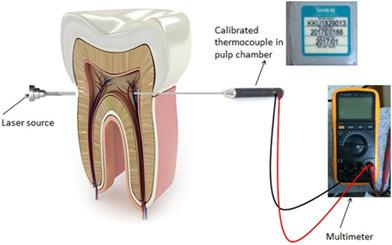当前位置:
X-MOL 学术
›
Microsc. Res. Tech.
›
论文详情
Our official English website, www.x-mol.net, welcomes your feedback! (Note: you will need to create a separate account there.)
Thermal, morphological, and spectral changes after Er, Cr:YSGG laser irradiation at low fluences on primary teeth for caries prevention
Microscopy Research and Technique ( IF 2.5 ) Pub Date : 2020-11-21 , DOI: 10.1002/jemt.23637 Merve Erkmen Almaz 1 , Nur Burcu Ulusoy 2 , Aylin Akbay Oba 1 , Ümit Erdem 3 , Mustafa Doğan 3
Microscopy Research and Technique ( IF 2.5 ) Pub Date : 2020-11-21 , DOI: 10.1002/jemt.23637 Merve Erkmen Almaz 1 , Nur Burcu Ulusoy 2 , Aylin Akbay Oba 1 , Ümit Erdem 3 , Mustafa Doğan 3
Affiliation

|
The aim of this study was to determine the temperature increase in the pulp chamber and possible thermal effects on molecular structure of primary teeth during the irradiation with Er,Cr:YSGG laser. Primary central incisors were divided into three groups (n = 20). Labial surfaces in each group were irradiated by Er,Cr:YSGG laser within different power and frequencies as following groups: I: 0.25 W, 20 Hz, II: 0.50 W, 20 Hz, III: 0.75 W, 20 Hz. A thermocouple was placed inside the pulp chamber so that the temperature increments were recorded during the enamel irradiation. Morphological changes of enamel surfaces were experimentally evaluated by SEM. Fourier‐transform infrared spectroscopy and RAMAN analyses were carried out to determine the differentiations in the molecular structure. The experimental results obtained were analyzed statistically by means of one‐way analysis of variance. Statistically significant differences were detected between groups (p < .05). Group III exhibited the highest values for the temperature parameters. Besides, the conical craters, cracks, and formation of ablation areas were observed for all the groups. Also, it was obtained that the hydroxyapatite lost the hydroxyl ions due to the thermal effect of the laser. Temperature rise throughout the Er,Cr:YSGG laser irradiation for prevention of primary enamel demineralization presented a positive correlation with the laser output power level. The formations of adverse morphological and spectral changes were detected on the surface of teeth after the laser application. On this basis, the Er,Cr:YSGG laser applications should be treated with much more caution considering enamel surface and pulpal tissues in primary teeth.
中文翻译:

Er, Cr:YSGG 激光以低能量密度照射乳牙预防龋齿后的热、形态和光谱变化
本研究的目的是确定在用 Er,Cr:YSGG 激光照射期间牙髓腔的温度升高和对乳牙分子结构可能的热影响。初级中切牙分为三组(n= 20)。各组阴唇表面分别用不同功率和频率的 Er,Cr:YSGG 激光照射如下组:I: 0.25 W, 20 Hz, II: 0.50 W, 20 Hz, III: 0.75 W, 20 Hz。将热电偶放置在牙髓腔内,以便在釉质照射期间记录温度增量。通过扫描电镜实验评估牙釉质表面的形态变化。进行傅里叶变换红外光谱和拉曼分析以确定分子结构的差异。通过单因素方差分析对获得的实验结果进行统计分析。组间检测到统计学显着差异(p< .05)。第三组的温度参数表现出最高值。此外,所有组均观察到锥形坑、裂纹和烧蚀区的形成。此外,由于激光的热效应,羟基磷灰石失去了氢氧根离子。整个 Er,Cr:YSGG 激光照射防止初级牙釉质脱矿的温度升高与激光输出功率水平呈正相关。激光应用后,在牙齿表面检测到不良形态和光谱变化的形成。在此基础上,考虑到乳牙的牙釉质表面和牙髓组织,应更加谨慎地对待 Er,Cr:YSGG 激光应用。
更新日期:2020-12-28
中文翻译:

Er, Cr:YSGG 激光以低能量密度照射乳牙预防龋齿后的热、形态和光谱变化
本研究的目的是确定在用 Er,Cr:YSGG 激光照射期间牙髓腔的温度升高和对乳牙分子结构可能的热影响。初级中切牙分为三组(n= 20)。各组阴唇表面分别用不同功率和频率的 Er,Cr:YSGG 激光照射如下组:I: 0.25 W, 20 Hz, II: 0.50 W, 20 Hz, III: 0.75 W, 20 Hz。将热电偶放置在牙髓腔内,以便在釉质照射期间记录温度增量。通过扫描电镜实验评估牙釉质表面的形态变化。进行傅里叶变换红外光谱和拉曼分析以确定分子结构的差异。通过单因素方差分析对获得的实验结果进行统计分析。组间检测到统计学显着差异(p< .05)。第三组的温度参数表现出最高值。此外,所有组均观察到锥形坑、裂纹和烧蚀区的形成。此外,由于激光的热效应,羟基磷灰石失去了氢氧根离子。整个 Er,Cr:YSGG 激光照射防止初级牙釉质脱矿的温度升高与激光输出功率水平呈正相关。激光应用后,在牙齿表面检测到不良形态和光谱变化的形成。在此基础上,考虑到乳牙的牙釉质表面和牙髓组织,应更加谨慎地对待 Er,Cr:YSGG 激光应用。



























 京公网安备 11010802027423号
京公网安备 11010802027423号